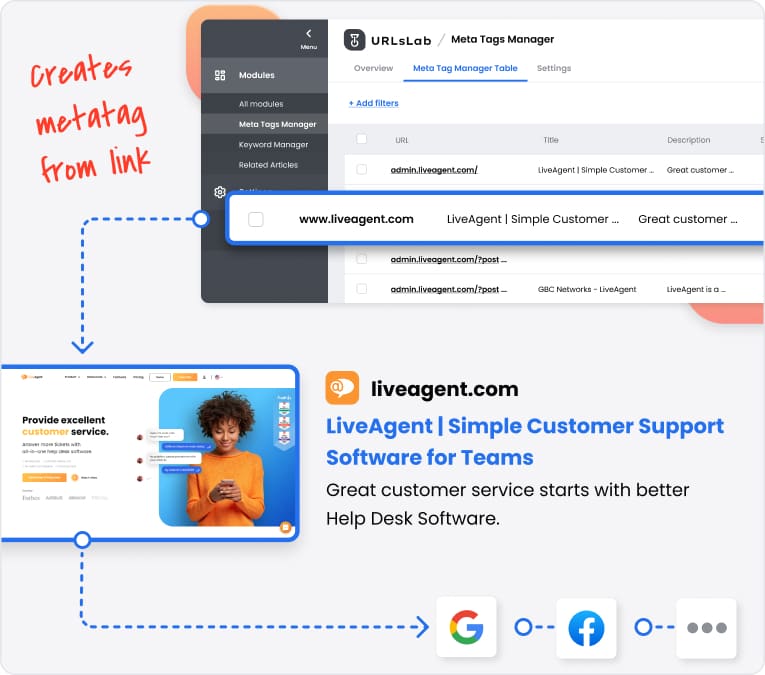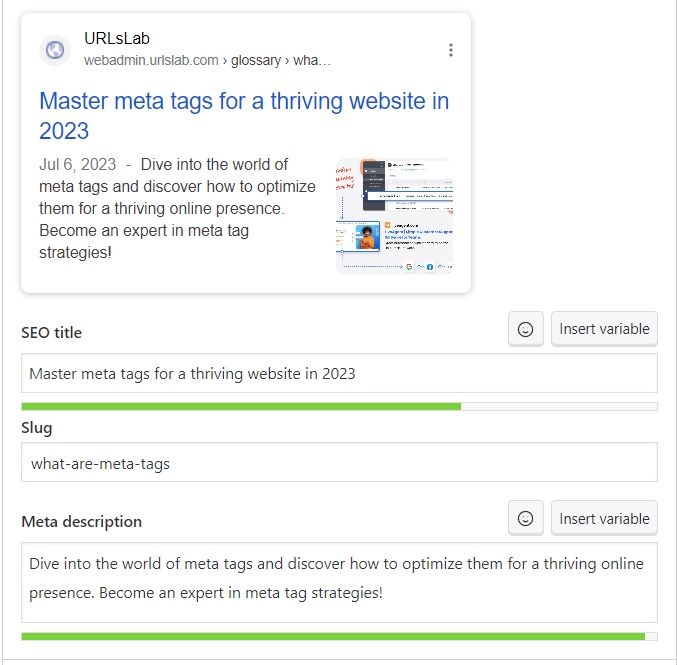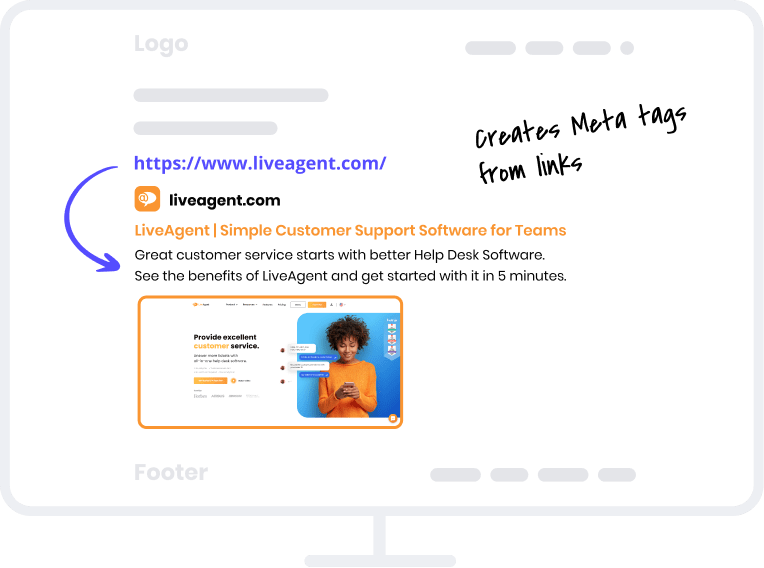Meta tags are a crucial component of a web page’s HTML code that conveys information to search engines regarding a page’s content, purpose, and attributes. They help improve search engine visibility by providing precise and relevant data when a page is indexed, and they play a critical role in Search Engine Optimization (SEO).
SEO meta tags specifically pertain to elements such as the meta title, meta description, and keyword tags that give search engines an overview of a page’s context. Among these, the meta description is particularly significant, as it serves as a summary of the page content and is displayed in search engine result pages (SERPs).
Effective website tags, which include well-crafted meta descriptions, are essential for attracting user attention and increasing click-through rates. Implementing strategic use of meta tags on your websites is crucial in boosting search engine visibility, generating online traffic, and ultimately, driving business growth.
Do meta tags help SEO?
Meta tags and SEO are closely linked, impacting a website's search ranking and visibility. As HTML code snippets in the website's header, meta tags provide search engines with information about the site's content. Key examples include meta descriptions and keyword tags, which influence user experience by presenting a brief content summary in search results.
SEO meta tags function as signals to search engines, allowing them to index and rank websites effectively. Properly implemented website tags directly impact rankings by helping search engines categorize the content. Indirectly, well-crafted meta tags increase user engagement, contributing to better search ranking. Using the proper meta tags allows business owners to reach a broader audience and drive more organic traffic to their websites.
Getting started with meta tags
Meta tags are essential for boosting your website’s search ranking and user experience. To effectively utilize meta tags, follow these steps:
Start by understanding the definition of a meta tag, which refers to a snippet of HTML code that relays crucial information about your site to search engines. Key SEO meta tags to focus on include the meta description, meta keyword tag, and meta header.
Select appropriate keywords for your website’s tags, prioritizing those relevant to your content and industry. Integrating these keywords into meta tags will optimize both SEO and user experience. Ensure that meta tags are situated within your website’s HTML header for easy identification by search engines.
Remember that metadata, especially the meta description, plays a significant role in influencing click-through rates. Therefore, it is important to create engaging and informative descriptions. Implementing these strategies will help improve your website’s search ranking, ultimately enhancing your online visibility and promoting growth.

Follow these tips when selecting and prioritizing meta tags:
- Research your target audience to understand their interests and search habits.
- Use keyword research tools like Google Keyword Planner, Moz, and SEMrush to identify relevant keywords, including long-tail keywords.
- Focus on crucial meta tags such as meta title, meta description, and meta keywords.
- Ensure each webpage has unique meta tags tailored to its content.
- Keep meta titles under 60 characters and meta descriptions under 155 characters.
- Write engaging meta descriptions for users, not just for search engines.
Understanding the basics of meta tags
Meta tags are essential components of a website’s SEO strategy, as they help search engines understand the website’s content. The significance of these SEO meta tags cannot be overstated, as they directly impact the user experience, influence website tags, and contribute to a website’s overall SEO ranking.
This glossary section aims to provide business owners with a comprehensive understanding of various meta tags for a website, such as meta description, robots meta tag, viewport meta tag, title tag, and canonical tags. Gain insight into how these meta tags on your website can optimize relevant keywords, reduce bounce rate, and ultimately match search intent.
By leveraging the power of HTML meta tags, business owners can enhance their online presence and boost their website’s SEO rankings through the effective implementation of various SEO meta tags in their HTML code.
What is a meta description?
A meta description is a vital element in search engine optimization (SEO), serving as a brief summary of a webpage’s content, usually within 150-160 characters. These website tags, written within the HTML, enhance the user experience by providing a concise preview of the content, helping users decide if the page is relevant to their search query. By incorporating relevant keywords and meta tags, businesses can improve their website’s SEO ranking.

A well-written meta description is crucial for SEO, as it impacts a website’s visibility and organic traffic. It helps search engine algorithms understand the webpage’s content and determines its relevancy to a user’s query. By incorporating relevant keywords and providing a concise summary, a well-crafted meta description can improve the website’s ranking on search engine results pages (SERPs), attracting more users and generating clicks.
A compelling meta description also enhances the user experience by offering a clear preview of the content, resulting in higher click-through rates (CTRs). High CTRs signal search engines the webpage’s relevance and quality, further contributing to its SEO ranking.
What is a robots meta tag?
A robots meta tag is an essential HTML code that guides search engines on crawling, indexing, and displaying a webpage, impacting its SEO ranking and user experience. This SEO metadata utilizes various website tags, such as meta descriptions, and keyword tags placed in the head section of a webpage’s HTML.
These attributes help search engines understand the content and display relevant keywords and descriptions accordingly. For example, meta descriptions provide a short summary of the page that may appear in search engine results. HTML meta tags guide search engines on how to crawl a website, enhancing its search engine optimization.
What is a viewport meta tag?
Viewport meta tags are essential HTML elements in responsive web design, optimizing the mobile user experience. Embedded in a website’s HTML ‘head’ section, they direct search engines on scaling and displaying content across various screen sizes. This ensures seamless navigation and content rendering for mobile users, enhancing the website’s search engine optimization (SEO).
Working in tandem with other SEO meta tags like meta descriptions and meta keyword tags, viewport meta tags provide search engines with valuable information about a webpage’s content. This metadata helps improve indexing and ranking, driving website visibility, engagement, and conversions. In summary, viewport meta tags boost mobile responsiveness, user experience, and SEO performance.
What is a title tag?
Title tags are crucial in SEO and user experience, as they serve as clickable headlines on search engine results pages. To create effective title tags, follow these best practices:
- use relevant keywords without stuffing,
- stay within the 50-60 character limit,
- write unique and descriptive tags that accurately depict the page content.
By adhering to these guidelines, you’ll optimize meta tags and improve your site’s overall performance in search engine rankings.
What are canonical tags?
Canonical tags, or “rel=canonical” links, are essential SEO meta tags that inform search engines about the preferred version of a webpage when multiple similar versions exist. They help prevent duplicate content issues and improve user experience.
To use canonical tags properly, follow these guidelines:
- First, insert the canonical tag in the HTML head section of the secondary webpage using: . This helps search engines identify the primary webpage.
- Second, ensure the canonical link points to the correct absolute URL.
- Lastly, use relevant keywords in meta descriptions and website tags without keyword stuffing.
By using canonical tags and balanced SEO meta tags, you can improve your website’s search engine rankings and user experience. Always ensure your website tags accurately represent the content for effective indexing and ranking. This approach follows the best practices of search engine optimization and website management.
Best practices for writing meta descriptions
A well-crafted meta description is crucial for both search engine optimization (SEO) and enhancing user experience. To create high-quality meta descriptions, focus on incorporating relevant keywords to help search engines understand your content and rank it accordingly. However, avoid keyword stuffing to prevent penalties.
Adequate keyword usage is vital, as it influences your website’s visibility on search results, directly impacting click-through rates and user engagement. To effectively optimize meta tags for your website, ensure to follow best practices, such as providing an accurate, enticing summary with a length of around 150 words.
By prioritizing keyword relevance and following optimization guidelines, business owners can significantly improve their website’s SEO performance and deliver a better user experience.
Make sure that every meta description on your site is unique
A unique meta description is crucial for SEO, as it gives users an overview of a page’s relevance to their search query. Search algorithms rely on unique meta-descriptions to differentiate and rank pages based on relevance.
To avoid duplicating content, craft distinct summaries for each page, focusing on specific keywords and topics. Utilizing meta tags, such as an HTML meta description and relevant tags for SEO, helps optimize your site, making it more visible in search results. Offering unique content and meta descriptions on every page will boost your online presence, attract organic traffic, and benefit your business in the long run.
Make sure your meta descriptions are of high enough quality
Creating compelling and informative meta descriptions is vital for boosting your website’s search engine ranking and attracting organic traffic. To achieve this, ensure the content is accurate, relevant to the targeted search query, and includes appropriate keywords. Look at meta tags examples as a guide for best practices.
Aim for a 150-word limit in your meta description to provide a clear and concise summary of the page’s content. Write high-quality content that engages potential visitors, and maintain consistency in SEO tags across your website for a coherent structure. By focusing on SEO metadata and catering to search queries and algorithms, you’ll improve your website’s search visibility and user engagement.
Automatically generating meta descriptions
Auto-generating meta descriptions involves creating concise summaries of webpages within the HTML meta description tag. This is essential for SEO purposes, as it helps search algorithms categorize the content for precise search query results, ultimately enhancing the website’s visibility.
Website owners can save time by using specialized software that automatically generates SEO metadata, such as meta keyword tags and content attributes. To optimize webpages further, website owners should use keywords in meta tags, ensure the meta description is accurate, and adhere to appropriate lengths.
In certain situations, auto-generated descriptions might be most appropriate—particularly when a website has numerous pages, making it time-consuming and impractical to manually write unique descriptions for each one. Nevertheless, it’s essential to ensure the accuracy of these descriptions in conveying high-quality content on the page. This can be achieved by using relevant keywords, well-structured meta tags, and an optimized meta title, ultimately supporting the website’s overall SEO strategy and enhancing user experience.
Pros and cons of using auto-generated meta descriptions
Business owners should weigh the benefits and drawbacks of using such descriptions. While time-saving, automated descriptions may not accurately represent the content or capture relevant keywords, potentially reducing search engine visibility and hindering website growth. Careful examination of tags for SEO is essential, considering both the advantages and disadvantages of auto-generated descriptions.
Consider automating descriptions for large websites to maintain consistency and efficiency. These descriptions can improve your site’s visibility and search rankings.
However, it’s crucial to review generated metadata periodically to ensure accuracy and relevancy. By incorporating best practices, you can enhance your website’s SEO strategy and attract more targeted traffic to your business.
Tools for automating meta description creation
Several popular tools and platforms have been developed to assist business owners in crafting compelling meta descriptions. These tools, categorized as assistive technology, enable users to auto-generate relevant and optimized descriptions for their web pages. Some of these platforms include Yoast SEO, All in One SEO, and SEOPressor.
However, among these options, our URLs Lab plugin stands out as the best. This powerful and versatile tool offers advanced features that streamline the process of creating unique meta descriptions that align with your target audience’s needs and interests. By opting for our URLs Lab plugin, you’ll not only save time and effort but also keep up with ever-changing search engine requirements and maximize the online reach of your business.

Conclusion
In conclusion, the use of meta tags plays a pivotal role in optimizing a website’s search engine performance and ranking. Meta tags provide essential information about a web page, allowing search engines like Google to understand its content and index it accordingly. Proper usage of SEO meta tags and crafting an effective meta description not only enhance a website’s visibility in search results but also improves overall user engagement by offering a concise and relevant summary of the page’s content.
It is crucial to implement the various tips and best practices discussed in this article to elevate your website’s search performance. By devoting time and effort to optimizing meta tags in HTML and creating appealing meta descriptions, you will inevitably strengthen your online presence and generate more organic traffic, ultimately driving the growth and success of your business.
FAQ
What are meta tags?
Meta tags are snippets of HTML code that describe the content of a webpage and provide additional information for search engines.
Why are meta tags important?
Meta tags are important because they help search engines understand the content on a page, improving the chances of the page being indexed and ranked accurately.
Do meta tags help SEO?
Yes, meta tags help with SEO by providing valuable information to search engines and improving the site’s visibility in search engine results pages.
How long should the meta description be?
The ideal meta description length is between 50 and 160 characters.
When does Google rewrite meta descriptions?
Google may rewrite meta descriptions when they believe the original description doesn’t accurately represent the page content or when it’s not optimized for user experience.
Header tags, essential for SEO, provide structure and context to web content. They guide search engines, improve readability, and indirectly boost SEO ranking. Use keywords wisely, stick to hierarchy, and make headers informative to maximize their effectiveness. Invest in effective SEO tools like URLsLab for improved website performance.
Crafting effective SEO titles is crucial for online marketing success. It's important to understand search intent, adhere to character limits, avoid keyword stuffing, and steer clear of common SEO title tag mistakes. Prioritize user experience and engagement to drive organic traffic and improve search rankings.
Meta keywords play a crucial role in SEO, providing context to web pages for search engines. They can include variations of target keywords and are categorized into singular and long-tail types. Using relevant and targeted meta keywords can enhance website visibility and searchability. Effective implementation is key for SEO success.
On-page SEO is crucial for website ranking and user experience. It includes keyword optimization, URL structure, internal links, and image optimization. This helps boost organic traffic, enhance website visibility, and improve relevance. Implementing on-page SEO strategies like creating compelling title tags and meta descriptions, setting SEO-friendly URLs, optimizing images, and adding schema markup is essential for website success. It also helps build trust and credibility with visitors and search engines. Tools like URLsLab plugin can automate and streamline the on-page SEO process for better performance.
Keyword ranking is crucial for website visibility and traffic. It reflects a site's performance in search engine results based on specific keywords. Good ranking attracts organic traffic and enhances brand recognition. Organic and paid ranking types require targeted strategies. Quality content, keyword research, and on-page SEO are key for improvement. Regular monitoring is essential for measuring effectiveness and seizing opportunities for improvement.
SEO is crucial for website visibility and user engagement. It involves keyword optimization, link building, and user experience enhancements, aiming to create valuable content that appeals to the target audience. Different types of SEO practices focus on various aspects to ensure websites are fully optimized for search engine algorithms. Investing time and resources in SEO can deliver a significant return on investment.
An entry page, or landing page, is the first page a user sees when visiting a website. It plays a crucial role in improving visibility, increasing conversion rates, and enhancing the user experience. There are three main types of entry pages: transactional, informational, and navigational. Examples include Amazon, Wikipedia, and Yahoo. Design and SEO optimization are important factors in creating a successful entry page.
Header tags, essential for SEO, provide structure and context to web content. They guide search engines, improve readability, and indirectly boost SEO ranking. Use keywords wisely, stick to hierarchy, and make headers informative to maximize their effectiveness. Invest in effective SEO tools like URLsLab for improved website performance.
Crafting effective SEO titles is crucial for online marketing success. It's important to understand search intent, adhere to character limits, avoid keyword stuffing, and steer clear of common SEO title tag mistakes. Prioritize user experience and engagement to drive organic traffic and improve search rankings.
Meta keywords play a crucial role in SEO, providing context to web pages for search engines. They can include variations of target keywords and are categorized into singular and long-tail types. Using relevant and targeted meta keywords can enhance website visibility and searchability. Effective implementation is key for SEO success.
On-page SEO is crucial for website ranking and user experience. It includes keyword optimization, URL structure, internal links, and image optimization. This helps boost organic traffic, enhance website visibility, and improve relevance. Implementing on-page SEO strategies like creating compelling title tags and meta descriptions, setting SEO-friendly URLs, optimizing images, and adding schema markup is essential for website success. It also helps build trust and credibility with visitors and search engines. Tools like URLsLab plugin can automate and streamline the on-page SEO process for better performance.
